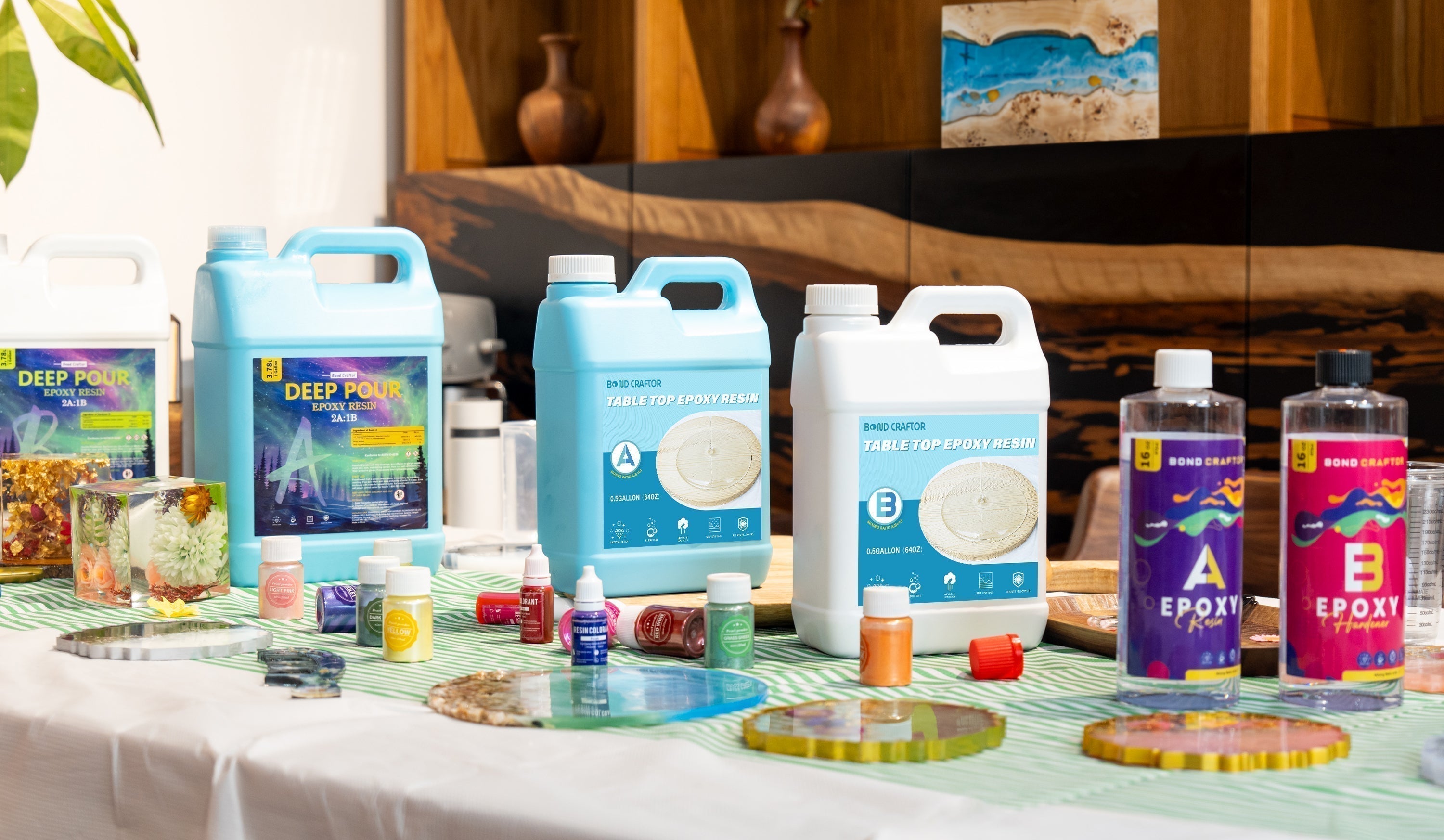By Venice Jakes
·
Jul 16, 2025
Differences Between Table Top Epoxy Resin and Other Epoxy Resins
1. Primary Purpose & Application Scenarios
Table Top Epoxy Resin:
Focuses on surface coating, decoration, and protection for visible, high-touch surfaces. Its core priorities are aesthetics (e.g., smoothness, gloss, transparency) and everyday durability. Typical applications include DIY handmade tabletops, wooden workbenches, resin art, river tables, or furniture coating.
Other Epoxy Resins:
Serve diverse purposes, including structural bonding, electronic potting, mold making, gap filling, industrial repairs, or low-visibility protective coatings. These epoxies prioritize functionality (e.g., strength, adhesion, insulation). Typical applications include aerospace/automotive structural bonding, concrete repair, PCB encapsulation, composite manufacturing, or hull sealing.
2. Viscosity & Flow Properties
Table Top Epoxy Resin:
Typically has low to medium viscosity (e.g., 500–1500 cP at 25°C). This allows it to self-level smoothly over large surfaces, minimizing brush marks, orange peel effects, or unevenness—critical for achieving a glass-like finish.
Other Epoxy Resins:
Viscosity varies significantly:
Structural epoxies (for bonding) often have high viscosity (2000–10,000+ cP) to prevent sagging on vertical surfaces or fill gaps.
Electronic potting epoxies may have medium viscosity, flowing into small crevices without excessive leakage.
Some low-viscosity industrial epoxies exist but prioritize penetration (e.g., for concrete sealing) over self-leveling.
3. Curing Time & Working Window
Table Top Epoxy Resin:
Designed with a longer working time (e.g., 45 minutes to 2 hours) to allow users to:
Mix large volumes without rapid thickening;
Eliminate bubbles using heat guns or torches;
Adjust decorative elements (e.g., adding pigments or inlays).
Full curing (hard enough for use) typically takes 24–72 hours, with final hardness developing over several days.
Other Epoxy Resins:
Fast-curing epoxies (with 5–30 minute working times) are used for quick repairs or assembly;
Structural epoxies may have longer curing cycles (24–48 hours) but prioritize ultimate strength over workability;
Industrial formulations may require heat curing (e.g., oven-based) for faster or more consistent results.
4. Surface Finish & Aesthetics
Table Top Epoxy Resin:
Typically cures to a high-gloss, mirror-like finish; many formulations include additives to enhance transparency.
Reduces flaws like brush marks or orange peel through leveling agents.
Strictly controls bubbles via low viscosity and defoaming additives, ensuring bubbles rise and pop before curing—critical for visible surfaces.

Other Epoxy Resins:
Aesthetics are usually secondary. For example:
Structural epoxies may cure to a matte or textured finish;
Potting epoxies often have a dull surface and may trap bubbles (irrelevant for hidden electronics);
Colored industrial epoxies (e.g., gray or black) prioritize opacity over transparency.
5. Chemical & Environmental Resistance
Table Top Epoxy Resin:
Optimized for daily use:
Water resistance: Resists spills, moisture, and humidity to prevent warping or delamination of substrates.
Chemical resistance: Withstands common household substances (e.g., alcohol, coffee, soda, mild cleaners).
UV stability: Most contain UV inhibitors to slow sunlight-induced yellowing (important for indoor and outdoor use).
Heat resistance: Tolerates hot mugs (typically up to 60–80°C, varying by brand).
Other Epoxy Resins:
Structural epoxies prioritize bonding strength over chemical resistance and may degrade in strong solvents.
Electronic potting epoxies focus on electrical insulation and thermal stability but may lack water or chemical resistance.
Marine epoxies (a subset) offer water resistance but lack UV stability, often used in shaded areas like below-deck.
6. Mechanical Properties
Table Top Epoxy Resin:
Balances durability and practicality:
Offers abrasion/scratch resistance sufficient to withstand daily wear (e.g., moving dishes, light impacts).
Has slight flexibility to avoid cracking on wooden surfaces (which expand/contract with humidity).
Not designed for high-load-bearing or structural bonding.
Other Epoxy Resins:
Structural epoxies provide high tensile strength, shear strength, and adhesion for bonding load-bearing structures (e.g., metal, concrete, composites).
Mold-making epoxies offer high hardness and dimensional stability for replicating intricate molds.
Flexible epoxies (e.g., for rubber bonding) prioritize elasticity over hardness.
7. Mixing Ratios & User-Friendliness
Table Top Epoxy Resin:
Features simplified mixing, usually with a 1:1 volume ratio, making it easy for DIY users to measure with basic tools like cups. It is also more forgiving of minor ratio errors—critical for hobbyists.
Other Epoxy Resins:
Mixing ratios are often more complex. Many structural or industrial epoxies use ratios like 2:1, 3:1, or weight-based proportions (e.g., 100:40), requiring precise measuring tools. Incorrect ratios can lead to incomplete curing (e.g., sticky surfaces or reduced strength), making them less forgiving.
8. Transparency & Color Stability
Table Top Epoxy Resin:
Cures to high transparency with minimal yellowing over time, thanks to UV stabilizers. It is compatible with pigments, dyes, or inlays (e.g., metallic powders, wood chips) without clouding.
Other Epoxy Resins:
Often opaque or tinted (e.g., gray structural epoxies). Even clear formulations (e.g., some adhesives) may lack UV stabilizers, leading to rapid yellowing under light.
9. Cost
Table Top Epoxy Resin:
Generally more expensive per liter due to specialized additives (e.g., UV inhibitors, leveling agents, defoamers) and stringent performance requirements.
Other Epoxy Resins:
Basic formulations (e.g., generic structural or craft epoxies) are cheaper, but high-performance industrial types (e.g., aerospace-grade) may be costly due to technical demands (for different reasons than table top epoxy).
Our Products
Bond Craftor's epoxy resin kit can be used for table tops, woodworking, and creative crafts. This crystal-clear formula provides a high-gloss finish that resists heat, water, scratches, and impacts. It features a 1:1 mixing ratio for easy use, with self-leveling properties. The BPA-free formula makes it safer for home, bar, and restaurant use on countertops and more. Each gallon covers up to 12.8 sq ft, and it cures fully within 16-20 hours, making it applicable for both beginners and professionals.
Summary
Table top epoxy resin is a user-friendly, aesthetics-focused formulation designed for smooth, durable, and visible surfaces, prioritizing transparency, flow, and resistance to daily wear. In contrast, other epoxy resins are engineered for functional performance—whether structural strength, chemical insulation, or rapid curing—with aesthetics taking a backseat. The choice depends on whether your project requires a "showcase surface" or a "workhorse material."



